To design a weekly digital detox without losing productivity, start by evaluating your current habits and setting clear goals, like limiting social media to 30 minutes daily. Establish tech-free zones and specific times for offline activities such as outdoor walks or hobbies, and communicate your plan to colleagues and family. Incorporate mindfulness practices to enhance focus and regularly monitor your progress. As you gradually reintegrate devices, you’ll discover balance strategies that support both well-being and productivity — keep exploring to learn more.
Key Takeaways
- Schedule dedicated tech-free periods during peak productivity hours to maintain focus without interruption.
- Communicate your detox plan clearly to colleagues and family to set expectations and ensure support.
- Gradually reintroduce essential devices, limiting use to specific tasks and times to prevent productivity loss.
- Incorporate mindfulness and alternative activities to reduce digital dependence while staying mentally refreshed.
- Track and review your progress weekly, adjusting boundaries and goals to sustain balance and productivity.
Assessing Your Digital Usage and Setting Clear Goals
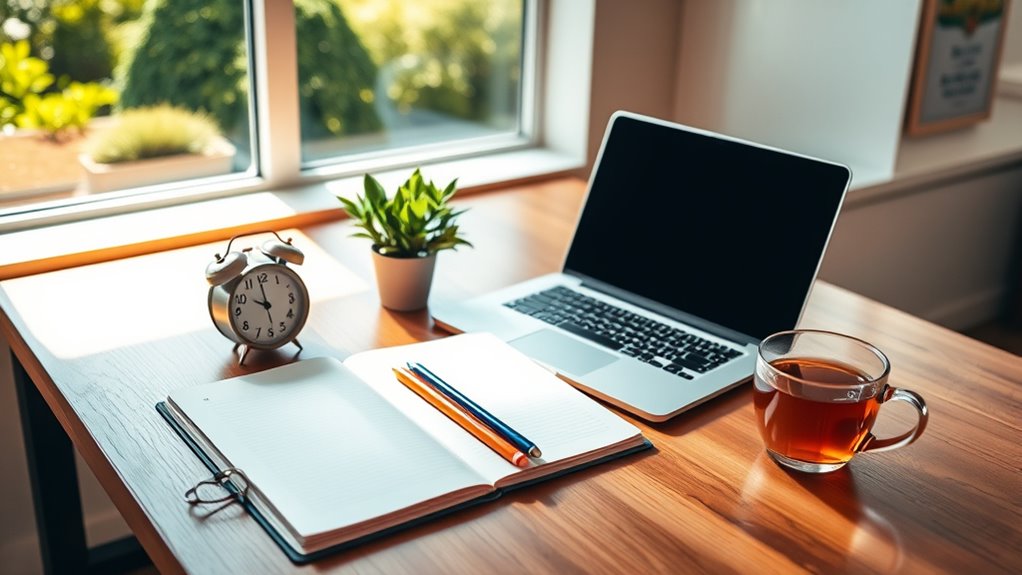
Before you can reduce your digital dependence, understanding how much time you spend online and on various devices is vital. Start by tracking your digital footprint—note which platforms, apps, and websites you visit most. This helps you identify patterns and areas where you may be wasting time or becoming overly dependent. As you assess your usage, also consider your online etiquette; how you interact online affects your reputation and relationships. Setting clear goals becomes easier once you know your habits. For example, you might aim to limit social media to 30 minutes daily or avoid screens an hour before bed. These concrete targets help you stay accountable and make your digital detox more effective. Knowing your habits is the first step toward meaningful change.
Identifying Key Distractions and Limiting Notifications
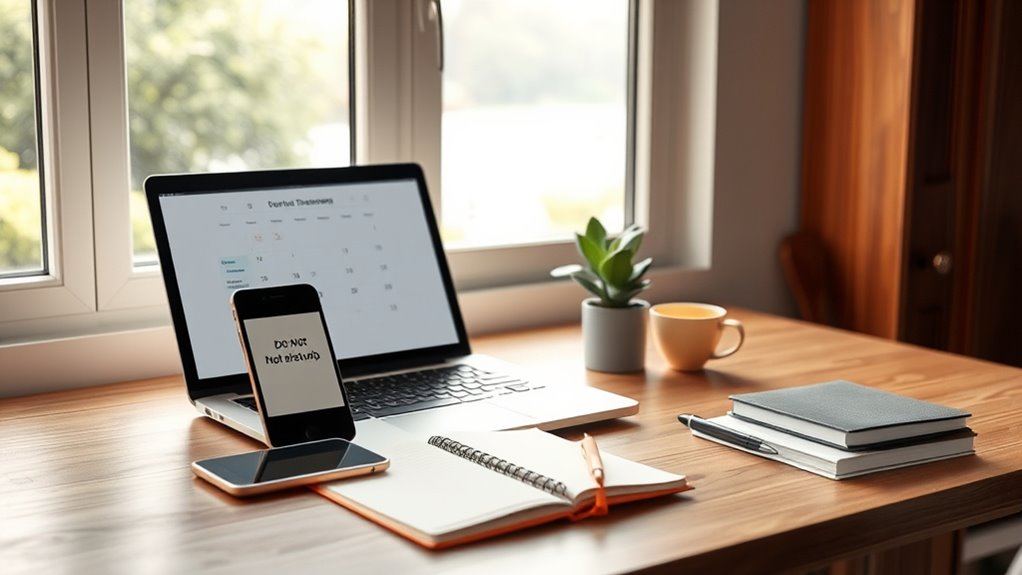
To reduce digital distractions, start by pinpointing which interruptions most disrupt your focus. Manage app alerts by turning off non-essential notifications and customizing settings to stay informed without overload. Taking these steps helps you regain control and create a more intentional digital environment. Recognizing common caffeine-related distractions can also improve your overall focus and energy levels throughout the day.
Pinpoint Digital Interruptions
Identifying digital interruptions begins with recognizing which notifications and distractions pull your attention away from important tasks. Social media alerts often cause frequent breaks, disrupting your focus and productivity. Similarly, constant email management can divert your time and mental energy, making it harder to stay on track. To pinpoint these interruptions, track when you feel distracted or tempted to check your devices. Notice patterns—are social media notifications more active at certain times? Does email pinging pull you away from deep work? Once you identify these key distractions, you can take steps to limit them. This awareness helps you create boundaries, reduce unnecessary interruptions, and set the stage for a more effective digital detox. Recognizing these triggers is the first step toward reclaiming your focus. Additionally, being aware of sound healing science can help you incorporate calming sounds into your environment to enhance concentration during focused work periods.
Manage App Alerts
Managing app alerts is a practical way to cut down on digital distractions that pull your attention away from important tasks. App alert management helps you identify which notifications are essential and which ones can be minimized or silenced. Start by reviewing your notification control settings to see which apps send frequent alerts, and disable or limit those that aren’t urgent. This reduces the constant pinging and visual clutter that disrupt your focus. Prioritizing alerts ensures you stay informed about critical updates without being overwhelmed. By controlling notifications proactively, you create a calmer digital environment that allows you to concentrate better and maintain productivity. Incorporating cookie management strategies can further enhance your digital detox by reducing unwanted data tracking and targeted ads. Effective app alert management is a simple yet powerful step toward a more mindful, distraction-free digital detox.
Customize Notification Settings
Have you ever noticed how certain notifications repeatedly pull your attention away from your priorities? To regain control, focus on notification customization and alert management. Start by:
- Disabling non-essential alerts to reduce distractions.
- Setting specific times for notifications, so they don’t interrupt your workflow.
- Prioritizing important alerts while silencing less urgent ones.
- Incorporate mindful decluttering strategies to regularly review and adjust your notification settings, ensuring they support your productivity goals.
Establishing Tech-Free Zones and Times in Your Routine

Creating designated tech-free zones and specific times for device use can considerably reduce digital distractions and help you reconnect with your surroundings. Start your day with tech free mornings, avoiding screens until breakfast or a set time. This helps you begin your day mindfully without digital interruptions. Similarly, establish device free dinners to foster quality time with family or friends, free from notifications and distractions. Setting these boundaries makes it easier to focus on the present moment and build healthier habits. Incorporating a digital detox into your routine can further enhance your mental clarity and overall well-being. Consistency is key—by establishing these zones and times, you create a routine that prioritizes real-world interactions over screens. Over time, you’ll notice reduced stress and increased awareness of your environment, making your weekly digital detox more effective and sustainable.
Choosing Activities to Replace Screen Time

When you cut back on screen time, it’s important to choose engaging activities that fulfill your needs for connection, relaxation, and productivity. Start by exploring alternative hobbies that excite you, like painting, cooking, or reading, which provide mental stimulation. Next, incorporate outdoor activities such as walking, cycling, or gardening to boost your physical health and reconnect with nature. Finally, consider group activities like team sports, local clubs, or volunteering, which help satisfy your social needs while keeping you active. These choices not only replace screen time but also enrich your daily routine, making your digital detox more enjoyable and sustainable. Engaging in mindfulness practices can further support your mental clarity and emotional balance during this transition. By selecting activities aligned with your interests, you’ll find it easier to maintain your digital detox without sacrificing fulfillment.
Communicating Your Digital Detox Plan to Colleagues and Family
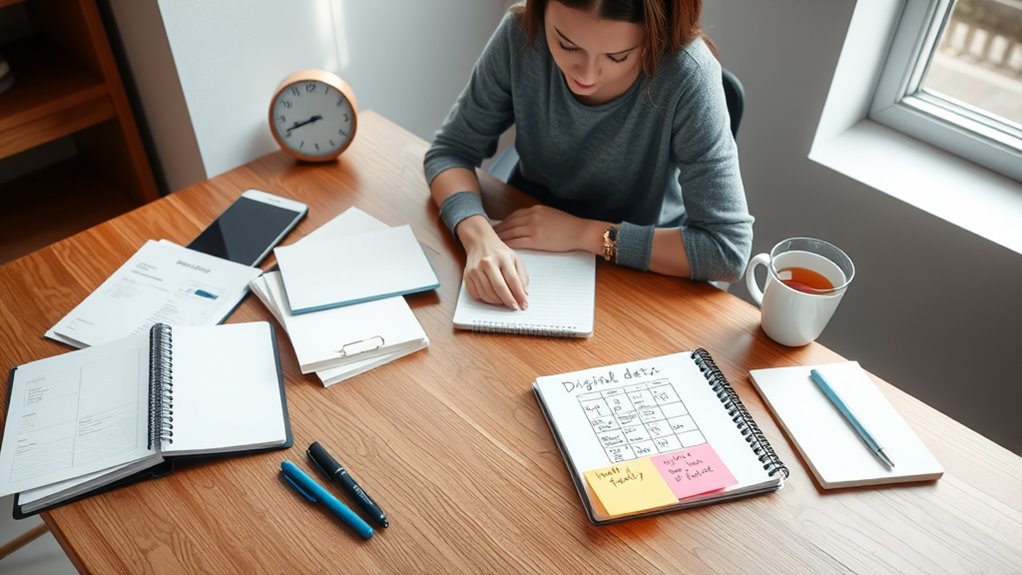
When sharing your digital detox plan, be clear about your goals to avoid misunderstandings. Respectfully set boundaries with colleagues and family so everyone knows what to expect. Prepare for questions by explaining your reasons and how they can support your effort. Clearly communicating your well-being objectives can foster understanding and cooperation during your detox.
Explain Your Goals Clearly
To guarantee your digital detox is successful, it’s essential to communicate your goals clearly to colleagues and family. Be specific about your intentions to set boundaries and foster mindfulness. Clearly explaining your plan helps others understand your needs and reduces misunderstandings. Consider these steps:
- Share your reasons for the detox, emphasizing the importance of mental clarity and focus.
- Outline the times you’ll be offline, so they know when you’re unavailable.
- Encourage support by asking for patience and cooperation during your detox period.
- Incorporate clear communication about your intentions to ensure everyone respects your offline hours and understands the purpose behind your digital detox.
Set Boundaries Respectfully
Setting boundaries respectfully is key to ensuring your digital detox goes smoothly without causing misunderstandings or frustration. Communicate your plan with clarity and kindness, emphasizing that your goal is to recharge and be more present. Use respectful communication to explain why these boundaries matter, making it clear it’s about self-care, not rejection. Practice boundary negotiation by listening to others’ concerns and finding mutually acceptable solutions. For example, let colleagues know you won’t check emails during specific hours, and inform family members about your offline times. Being transparent about your intentions helps prevent confusion and sets a positive tone. Remember, respectful communication fosters understanding and cooperation, making your digital detox a supportive experience for everyone involved. Incorporating tools like portable camping toilets can also help you disconnect more fully by reducing worries about logistics while away.
Prepare for Questions
Have you thought about how you’ll explain your digital detox to colleagues and family? Preparing clear responses helps set expectations and supports your digital minimalism goals. Consider these steps:
- Share your reasons for establishing tech boundaries, emphasizing the benefits of focus and mental clarity.
- Explain that your digital detox isn’t about disconnecting completely but prioritizing meaningful interactions.
- Reassure them that you’ll still be available for urgent matters, but you’ll be limiting non-essential device use.
- Remember that good communication can help others understand your intentions and reduce potential misunderstandings.
Incorporating Mindfulness and Relaxation Practices
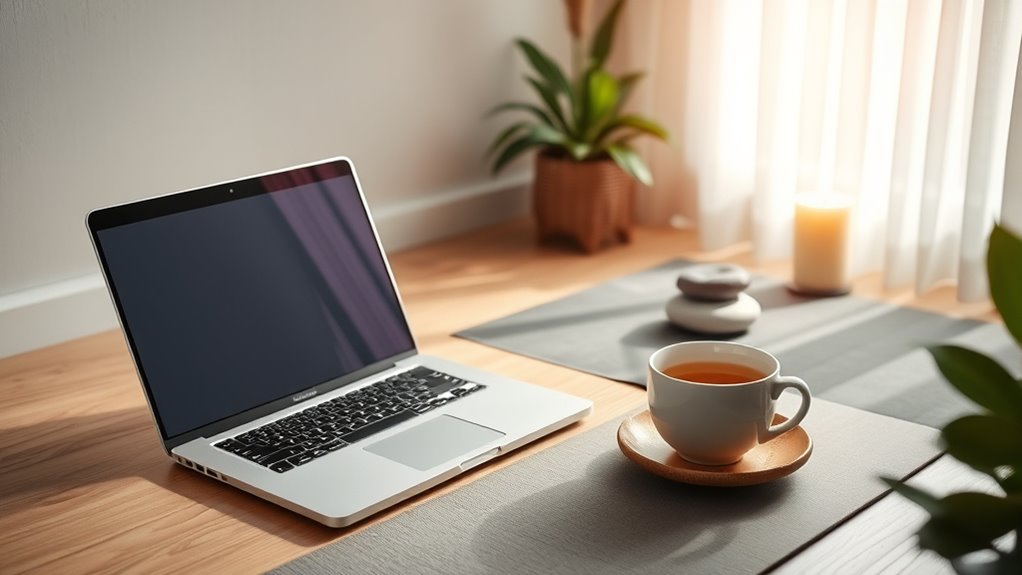
Incorporating mindfulness and relaxation practices into your weekly digital detox can considerably enhance your mental clarity and emotional well-being. Engaging in mindfulness meditation helps you stay present, reducing stress caused by constant notifications. Relaxation techniques like deep breathing or progressive muscle relaxation calm your nervous system and promote mental refreshment. To make this easier, try the table below for quick ideas:
| Practice | Description |
|---|---|
| Mindfulness Meditation | Focus on your breath, observe thoughts without judgment. |
| Deep Breathing | Inhale slowly, hold, then exhale fully to relax. |
| Body Scan | Notice sensations in each body part, releasing tension. |
| Guided Imagery | Visualize calming scenes to soothe your mind. |
| Yoga or Stretching | Incorporate gentle movements to release physical and mental stress. |
Monitoring Progress and Making Adjustments
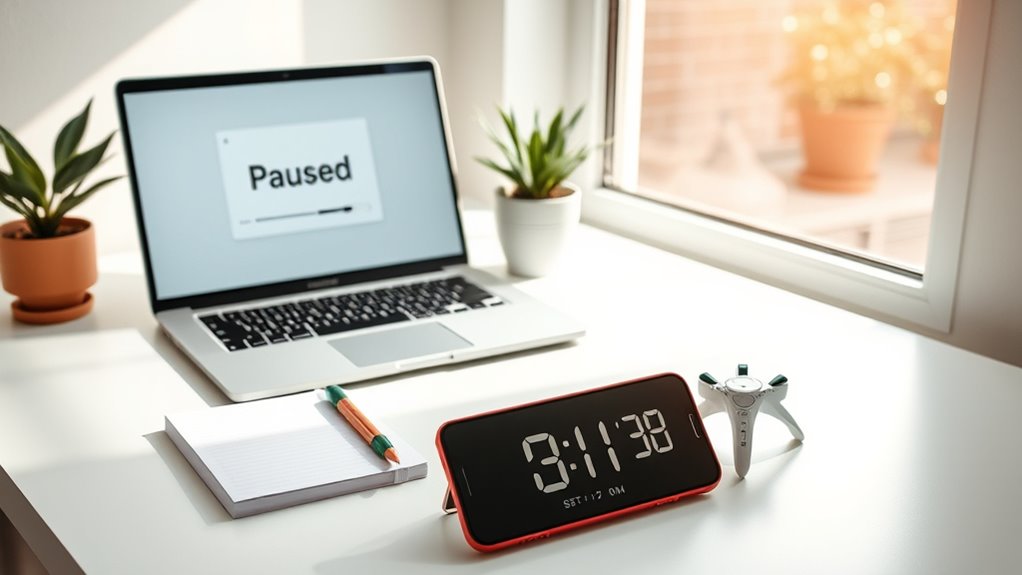
Tracking your progress during a digital detox helps you understand what’s working and where adjustments are needed. By monitoring milestones, you can see how well you’re reducing screen time and improving focus. To stay on track:
- Record daily achievements and setbacks to evaluate your efforts.
- Review your progress weekly, noting any patterns or challenges.
- Adjust strategies as necessary, like modifying detox days or setting new goals.
This approach keeps you aware of your habits and ensures your detox remains effective. If you notice you’re struggling to disconnect, consider shifting your strategy—perhaps limiting certain apps or increasing offline activities. Regularly monitoring and tweaking your plan helps maintain momentum and prevents burnout, making your digital detox sustainable and productive.
Maintaining Balance: Gradually Reintegrating Digital Devices

After completing your initial digital detox, it’s important to reintroduce devices gradually to maintain the benefits you’ve gained. Sudden reentry can disrupt your digital balance and lead to overwhelm. Start by reintroducing essential devices, like your phone or laptop, for limited periods each day. Set specific goals for device use, focusing on productivity and meaningful connection. As you adjust, monitor how each reintegration affects your focus and stress levels. Avoid the temptation to dive back into full-screen sessions immediately. Instead, prioritize intentional usage that aligns with your wellness goals. Over time, you’ll develop a sustainable device reintegration plan that supports your digital balance without sacrificing productivity or mental clarity. This thoughtful approach helps you enjoy the benefits of technology while preserving your well-being.
Reflecting on Benefits and Planning for Future Detoxes
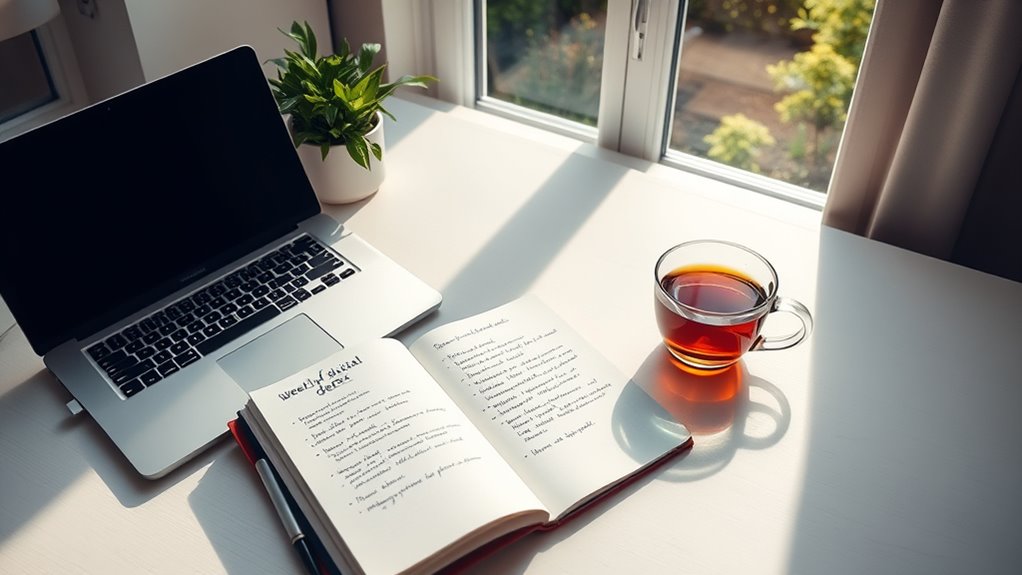
Reflecting on the benefits you’ve experienced from your digital detox can deepen your understanding of how reducing screen time has impacted your well-being. It helps you recognize improvements in mental clarity and emotional resilience. To make future detoxes more effective, consider these steps:
- Identify specific benefits you’ve noticed, like reduced stress or better focus.
- Assess how these benefits influence your daily life and productivity.
- Plan adjustments for next time, such as longer detox periods or different activities to replace screen time.
Frequently Asked Questions
How Can I Ensure My Work Productivity Isn’t Affected During a Digital Detox?
To keep your productivity intact, focus on effective time management and task prioritization. Before your digital detox, plan your day by identifying high-priority tasks and setting specific goals. Use tools or a planner to stay organized. During your detox, limit access to non-urgent work emails or messages. This way, you’ll maintain focus, prevent work piling up, and return refreshed, ready to tackle your tasks without feeling overwhelmed.
What Are Effective Ways to Handle Urgent Digital Needs During Detox Days?
When handling urgent digital needs during detox days, you should set up emergency plans and alternative communication methods beforehand. Keep a designated phone or device for essential contacts, and inform colleagues or family about your limited availability. This way, you can quickly address urgent matters without fully breaking your detox. By planning ahead, you make certain your detox remains effective while still handling those few critical digital needs efficiently.
How Do I Maintain Social Connections Without Digital Devices?
You might think social connections rely solely on digital devices, but offline socializing proves otherwise. Handwritten communication adds a personal touch that deepens bonds, making your relationships more meaningful. During your detox, schedule regular meetups or phone calls to stay connected. By prioritizing face-to-face interactions and handwritten notes, you maintain your social network without digital distractions, proving that genuine connections thrive beyond screens.
Can Digital Detoxes Help Improve Mental Health Long-Term?
Digital detoxes can indeed boost your mental health by providing significant stress reduction. When you take intentional breaks from screens, you give your mind a chance to relax and reset, which can lead to long-term mental health benefits. Regular detoxes help reduce anxiety and improve focus. By making digital breaks a habit, you support your overall well-being and create a healthier balance between technology use and mental health.
What Tools or Apps Can Support My Digital Detox Journey?
Think of your digital detox as a gentle river flowing away from distractions. Apps like Forest and Freedom act as your skilled paddles, helping you stay offline and focused. Use mindfulness techniques with Headspace or Calm to anchor yourself, making offline activities more fulfilling. These tools guide you like a compass, keeping you on course toward mental clarity while enjoying the serenity of real-world moments.
Conclusion
So, congratulations on surviving your digital detox—your inbox may be a mess, but hey, at least you’re not glued to your screen. Remember, the goal isn’t to become a tech hermit, but to regain control without turning life into a low-tech nightmare. Keep tweaking your plan, stay mindful, and don’t forget: a little screen time is fine, unless you’re trying to convince everyone you’ve become a digital minimalist overnight.









